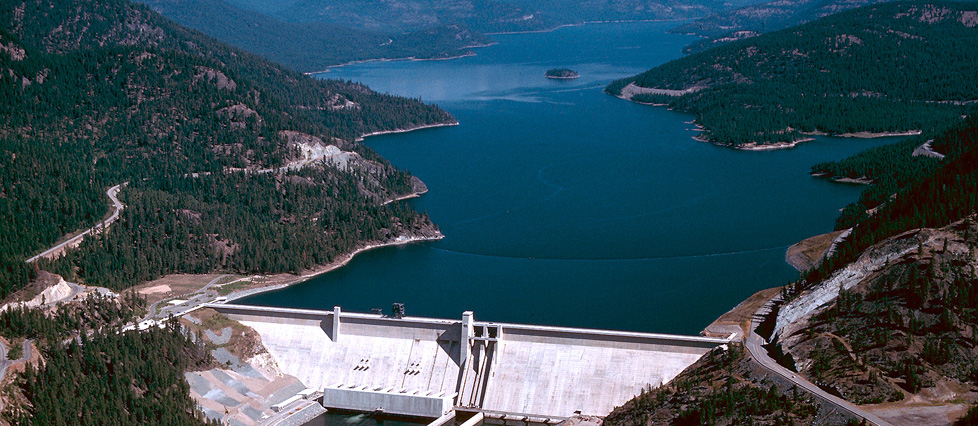Adding to Treaty Purposes
Issue: As implemented in 1964, the Columbia River Treaty (Treaty) addresses two primary purposes – hydropower and flood risk management. Ecosystem-based Function has been proposed by the Columbia Basin Tribes as a third primary purpose for the Treaty. This proposal has been widely accepted by regional sovereigns and stakeholders in the U.S. as integral to modernizing the Treaty. It is vital to Columbia Basin Tribes, as well as the First Nations of Canada, that a modernized Treaty addresses the Columbia Basin using a watershed approach that fully and equitably integrates Ecosystem-based Function, hydropower, and Flood Risk Management on both sides of the border.
Solution: The Columbia Basin Tribes believe the U.S. should pursue adding Ecosystem-based Function as a third primary purpose to the Treaty. This would mean that Ecosystem-based Function is fully integrated with Flood Risk Management and hydropower into the operations and recognized benefits of the Treaty.
Background: Since time immemorial, the rivers of the Columbia Basin have been, and continue to be, the life blood of the Columbia Basin Tribes. Columbia Basin Tribes view the ecosystem of the Columbia Basin watershed as its ability to provide, protect and nurture cultural resources, traditions, values and landscapes throughout its’ length and breadth. Clean and abundant water that is sufficient to sustain healthy populations of fish, wildlife, and plants is vital to holistic Ecosystem-based Function and life itself. A restored, resilient and healthy watershed will include Ecosystem-based Function as described by the definition that has been adopted by the Columbia Basin Tribes.
Discussion: A modernized Treaty needs to address the Columbia Basin using a watershed approach that integrates Ecosystem-based Function, hydropower, and Flood Risk Management on both sides of the border. This was not done in the past and we are now dealing with a Treaty that is unable to address the needs and rights of the peoples of the Columbia Basin in this regard. In addition, the Treaty is antiquated, which points to the need for a modernized Treaty to be able to change and keep up with evolving needs and values of society. A 60 year period before changes can occur to the Treaty is not practical or acceptable in the future. Incorporating Ecosystem-based Function in a modernized Treaty is vital as well as incorporating implementation procedures such as adaptive management that can keep a modernized Treaty modern over time. Finally, negotiation and implementation of a modernized Treaty needs to include the tribes to ensure that tribal rights related to Ecosystem-based F are sufficiently addressed in the future.
Summary:
- Ecosystem-based Function (EbF) was not addressed, and therefore not included, when the Columbia River Treaty (CRT) was implemented in 1964.
- EbF needs to be added to a modernized CRT as a primary purpose along with Flood Risk Management (FRM) and hydropower.
- EbF will result in a restored, resilient and healthy Columbia Basin watershed.
- While much has been done to address the adverse effects of hydropower development and operations on Columbia Basin EbF, EbF is not the same as managing the Columbia Basin to address fish and wildlife listed under the Endangered Species Act.
- Modernizing the CRT by incorporating EbF and rebalancing the three primary purposes will take more regional analysis and deliberation to determine appropriate options and actions. This needs to start immediately and continue during the negotiation and implementation of the modernized CRT.
- Optimizing the three primary purposes of the CRT through rebalancing to achieve modernization will occur in the negotiation and implementation of the CRT and should consider all associated costs and benefits to the Columbia Basin watershed including Canada.
- Negotiation and implementation of the modernized CRT needs to include full tribal participation to ensure that interests related to EbF are appropriately and sufficiently addressed during its implementation.
Contact:
Jim Heffernan, CRITFC (503) 238-0667, hefj@critfc.org
Keith Kutchins, UCUT (509) 209-2411, keith@ucut-nsn.org
Robert Austin, USRT (503) 880-8164, Robert.austin@uppersnakerivertribes.org
Taylor Aalvik, Cowlitz, (360) 575-3306, taalvik@cowlitz.org
John Marsh, CSKT, (503) 341-6237, jhmarsh@comcast.net
Original Treaty Purpose
The Columbia River Treaty’s two purposes are flood control and hydropower development. The needs of the ecosystem weren’t included.

